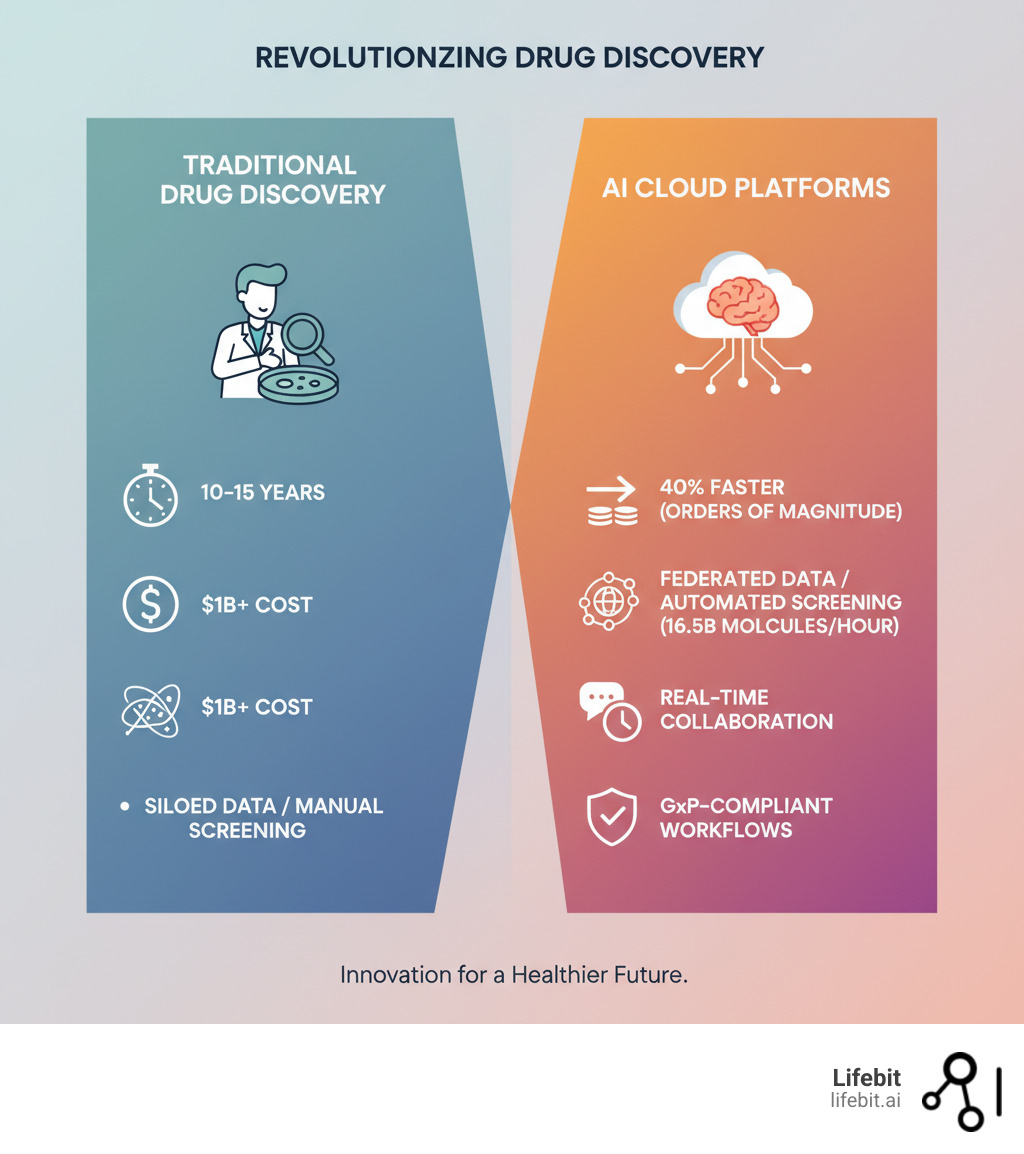The Complete Guide to Cloud AI Drug Discovery Platforms

Stop Wasting Billions—AI Cloud Drug Findy Is Here
Traditional drug findy costs over $1 billion and takes 10-15 years. AI-powered cloud platforms are cutting that timeline by 40% and slashing costs by orders of magnitude. They combine generative AI, supercomputing, and federated data analysis to achieve what was once impossible—all without moving sensitive data out of secure environments.
The shift is real. Projects that once took years now reach Phase II trials in 14 months. Previously “undruggable” compounds are now viable targets. Researchers can now run AI models on petabytes of real-world evidence—securely, compliantly, and in real time.
I’m Maria Chatzou Dunford, CEO and Co-founder of Lifebit. With over 15 years of experience building federated data analysis platforms, I’ve seen how cloud based drug findy platforms that use artificial intelligence are reshaping pharma and which capabilities truly make a difference.

Terms related to Which companies offer a cloud based drug findy platform that uses artificial intelligence?:
- drug findy platform definition
- data intelligence platform
- end to end drug discovery
The Secret Weapon: How AI and Cloud Computing Shatter Old Drug Findy Limits
The old way of drug findy involved manually screening thousands of compounds over months, with most attempts leading to dead ends. Now, AI can screen billions of molecules in an hour, delivering a ranked list of promising candidates with predicted toxicity and optimized variants. This isn’t science fiction; it’s the reality powered by the combination of artificial intelligence and cloud computing.
The AI Tech That’s Changing Everything
A whole arsenal of AI capabilities is solving previously impossible problems:
- Generative AI: Instead of just analyzing existing molecules, it creates entirely new ones from scratch. It designs millions of novel compounds optimized for specific properties, powering the pipeline from target evaluation to clinical studies.
- Machine Learning and Deep Learning: These prediction engines learn from massive datasets of past drug candidates to forecast how a new molecule will behave. They predict binding affinity, toxicity, and absorption, getting smarter with every new piece of data.
- Supercomputing: Cloud-based high-performance computing provides the raw power to test billions of molecular interactions in minutes, running complex quantum molecular design and AI models at an unprecedented scale.
This technology stack transforms the findy process. For target identification, AI sifts through biological data to find the most promising proteins or pathways, even spotting druggable pockets on once-impossible targets. For molecule generation, it designs novel ligands from a near-infinite virtual chemical space. For ADMET prediction (Absorption, Distribution, Metabolism, Excretion, and Toxicity), it weeds out problematic candidates early, preventing costly failures. And in virtual screening, it tears through libraries of billions of compounds in hours, not months. This is the core of the AI-Powered Drug Discovery Ultimate Guide.
Why Cloud Matters: Scale, Speed, and Global Access
AI is the brain, but the cloud is the body. Drug findy generates massive multi-omics, simulation, and clinical datasets. Building the infrastructure to process this is prohibitively expensive.
Cloud platforms solve this with on-demand scalability. You can spin up massive compute power to train a deep learning model and scale it down when finished, paying only for what you use. This provides immediate time-to-value, cutting pipeline deployment from over a year to a matter of weeks.
The cloud also solves the data accessibility problem. It creates secure environments where siloed datasets from different labs and countries can be integrated and analyzed by authorized researchers, enabling global collaboration in real time. Most importantly, cloud platforms are democratizing access to cutting-edge AI and supercomputing, making these tools available to biologists and chemists, not just machine learning experts. This shift is reshaping the entire Cloud-Based Drug Discovery Platforms Market.
Which Cloud AI Platform Can Transform Your Drug Findy? A 2025 Guide
Companies that offer cloud based drug findy platforms that use artificial intelligence are reimagining the entire R&D journey, from initial target identification to smarter clinical trials. AI is changing each phase:
- Target Identification & Validation: AI digs through genomic and proteomic data to spotlight novel disease targets, confirming they are worth pursuing.
- Hit Identification: Instead of screening thousands of compounds over weeks, AI-driven virtual screening evaluates billions in hours.
- Lead Optimization: Generative AI designs molecular modifications to boost efficacy and reduce toxicity, predicting how small changes will impact performance before a molecule is ever synthesized.
- Preclinical & Clinical Trials: AI predicts potential toxicities to guide efficient lab experiments and analyzes real-world data to design clinical trials with higher success rates, turning them from expensive gambles into data-driven strategies. This is a key part of modern AI in Drug Development.
Lifebit: The Only Cloud AI Platform Built for Secure, Federated Drug Findy
The biggest roadblock in drug findy isn’t just computational power; it’s secure access to the massive, sensitive, globally distributed datasets that hold the answers. Patient data, genomic information, and proprietary research are scattered and siloed across institutions and countries. Moving this data to a central location is a regulatory and security nightmare.
That’s why we built Lifebit as a federated AI platform. Our approach is fundamentally different: we enable secure, real-time analysis of global biomedical data without moving it. Your AI models travel to the data, learn from it behind the organization’s firewall, and bring back insights—not the raw data. No data migration, no compliance headaches, and no security compromises.
This federated approach open ups unprecedented opportunities. Imagine training an AI model on genomic data from ten different cancer centers simultaneously, with each contributing insights while protecting patient privacy. Our platform, which includes a Trusted Research Environment (TRE) and Trusted Data Lakehouse (TDL), is designed for this challenge, handling complex hybrid data ecosystems for secure collaboration at scale. You can Explore the Lifebit Platform to see how it works.
How Lifebit’s Platform Accelerates Every Stage—From Target to Trial
Our federated AI platform is engineered to accelerate every stage of drug findy:
- Federated Learning: We train AI models on distributed datasets to overcome data silos, allowing you to leverage vast, diverse real-world evidence for more robust target identification and validation.
- Integrated Knowledge & Analytics: We integrate knowledge graphs to connect disparate biological information, from gene pathways to chemical properties. Our advanced AI/ML analytics enable virtual screening of billions of compounds and generative design of novel molecules.
- Tackling ‘Undruggable’ Targets: By integrating diverse data types like proteomics and structural biology, our platform provides a holistic view that reveals cryptic pockets on challenging proteins, opening up new therapeutic avenues.
- Precision & Compliance: We help stratify patient populations for more effective clinical trials by securely analyzing real-world data. Our platform is built with GxP compliance in mind, ensuring data security, integrity, and auditability throughout your R&D process. This approach is so trusted that regulatory agencies are using our platform for collaborative review.
The financial impact is substantial, with industry data showing a 395% ROI for organizations making this transition. Our platform eliminates bottlenecks while keeping your data secure, your research compliant, and your team focused on finding the next breakthrough.
Navigating the Cloud: Security, Collaboration, and Business Models
Moving drug findy to the cloud is about more than just speed; it’s about protecting your most valuable assets, enabling teamwork, and accessing technology affordably. For cloud based drug findy platforms that use artificial intelligence, security, collaboration, and business models are paramount.

Fortifying Your Future: Data Security, IP, and Regulatory Compliance
The data you work with—patient genomics, proprietary molecular structures—is incredibly sensitive. Cloud security is the foundation of modern R&D. This means multi-layered protection, including end-to-end encryption and strict, auditable access controls.
Protecting your intellectual property (IP) is just as critical. Every novel compound and insight is your competitive advantage. A secure cloud platform must guarantee that what you create stays yours, with ironclad controls over access and ownership.
Then there’s the regulatory maze. Your platform must comply with GxP standards for research and clinical trials. If you handle patient data, compliance with regulations like HIPAA in the United States and GDPR in Europe is non-negotiable. At Lifebit, we built our platform with federated governance and GxP compliance from day one. Our focus on AI-Enabled Data Governance ensures your research can move forward with confidence.
Powering Progress: Collaboration and Business Models
Modern drug findy is a team sport. Cloud platforms enable real-time collaboration between chemists, biologists, and data scientists, regardless of location. Shared workspaces, version control, and secure data sharing with external partners are built-in.
Lifebit’s federated analysis takes this further. Collaborators can work together without ever moving or sharing their raw data. The analysis happens securely where the data lives, opening up partnerships that were previously impossible.
Accessing these capabilities is flexible:
- SaaS (Software as a Service): Most platforms operate on a subscription model, giving you instant access to tools and infrastructure without the need to buy or maintain hardware.
- Strategic Partnerships: These arrangements allow organizations to combine their domain expertise with a platform’s technology, sharing costs, risks, and rewards.
- PaaS (Platform-as-a-Service): For larger organizations with unique needs, PaaS models provide a foundation to build custom applications and workflows.
These models democratize access, allowing a five-person startup to tap into the same cutting-edge AI as a global pharmaceutical giant.
The Future Is Federated: Break Down Data Silos, Accelerate Breakthroughs
The numbers are clear: cloud-based AI platforms are fundamentally changing how drugs are finded. We’re not just seeing incremental improvements; we’re witnessing a revolution in R&D.
Open uping Potential: Benefits vs. Traditional Methods
Contrast the old way—10-15 years and over $1 billion per drug—with what’s happening today.
- Cost Savings: Cloud platforms slash the enormous expense of building and training large AI models, freeing up resources for more research.
- Time Reduction: Projects are reaching Phase II trials in as little as 14 months. Researchers spend more time on science and less on infrastructure.
- Higher Success Rates: By screening billions of compounds and predicting properties with precision, platforms are achieving remarkable success, even with targets once labeled “undruggable.”
But all this AI power needs fuel: diverse, high-quality, real-world data. The problem is that this data is locked away in data silos. Biomedical data is fragmented across hospitals, research labs, and companies, governed by different regulations and security protocols. This data access challenge has been the biggest bottleneck. How do you train AI on these vast datasets while respecting privacy, protecting IP, and maintaining data sovereignty?
The Horizon: A Federated Future
The answer isn’t to move all the data to one place. It’s to bring the analysis to where the data already lives. This is the promise of federated learning—a paradigm shift in data science.
Imagine an AI model training on genomic data from ten hospitals in different countries without a single patient record ever moving. The model travels to the data, learns locally, and shares only its learnings, not the raw data. Each institution maintains complete control, complying with regulations like GDPR and HIPAA, while contributing to a global model that is far more powerful than any single organization could build alone.
This is how we break down data silos without breaking data governance. It’s how we enable real-time evidence analysis at a global scale. And it’s exactly what we’ve built at Lifebit.
This approach directly fuels AI for Precision Medicine—tailoring treatments to individual patients. It’s the foundation of The Future of Drug Development: Drug Discovery 2.0—an ecosystem where data flows securely, AI models train collaboratively, and insights are generated in real-time.
The question “Which companies offer a cloud based drug findy platform that uses artificial intelligence?” is really asking who is building the infrastructure for this next era of medicine. The answer lies with those who solve not just the computational challenges, but the trust, governance, and collaboration challenges that have held us back.
Conclusion: Don’t Let Legacy Tech Hold You Back—Start Your Next Findy in the Cloud
The pharmaceutical industry can no longer afford the traditional path of $1 billion budgets and 10-15 year timelines. Cloud based drug findy platforms that use artificial intelligence are rewriting the rules, progressing from target to trial in as little as 14 months and achieving success on once-impossible targets.
Generative AI, machine learning, and cloud supercomputing are making this possible. But the true breakthrough is federated, secure analysis—the ability to open up insights from vast, distributed datasets without ever compromising privacy or moving sensitive data.
At Lifebit, our federated AI platform is built on this principle. We enable you to analyze distributed, sensitive datasets without moving them. You can tap into multi-omics data and real-world evidence across institutions and geographies, all while maintaining top-tier security, governance, and GxP compliance. You get the insights; the data stays protected.
Legacy systems create bottlenecks and hide crucial insights. In an industry where time equals lives saved, that’s unacceptable. The tools to change this are here and proven.
What could your team accomplish with secure, real-time access to global biomedical data? How many years could you cut from your next program?
Explore the Lifebit Platform and find how our federated AI can transform your journey from findy to patient impact. The future of drug findy is here—don’t get left behind.

